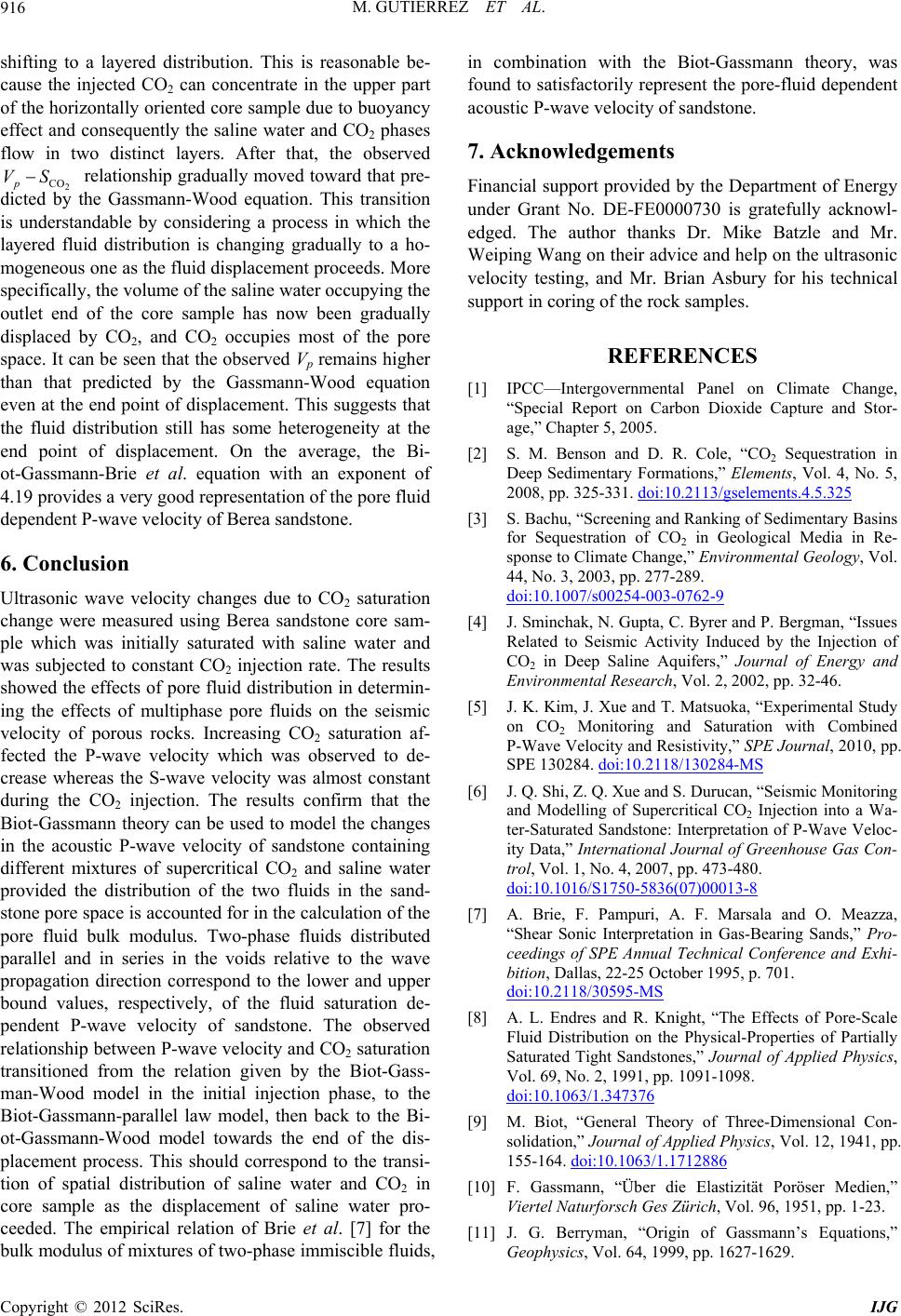
M. GUTIERREZ ET AL.
916
shifting to a layered distribution. This is reasonable be-
cause the injected CO2 can concentrate in the upper part
of the horizontally oriented core sample due to buoyancy
effect and consequently the saline water and CO2 phases
flow in two distinct layers. After that, the observed
2
COp relationship gradually moved toward that pre-
dicted by the Gassmann-Wood equation. This transition
is understandable by considering a process in which the
layered fluid distribution is changing gradually to a ho-
mogeneous one as the fluid displacement proceeds. More
specifically, the volume of the saline water occupying the
outlet end of the core sample has now been gradually
displaced by CO2, and CO2 occupies most of the pore
space. It can be seen that the observed Vp remains higher
than that predicted by the Gassmann-Wood equation
even at the end point of displacement. This suggests that
the fluid distribution still has some heterogeneity at the
end point of displacement. On the average, the Bi-
ot-Gassmann-Brie et al. equation with an exponent of
4.19 provides a very good representation of the pore fluid
dependent P-wave velocity of Berea sandstone.
VS
6. Conclusion
Ultrasonic wave velocity changes due to CO2 saturation
change were measured using Berea sandstone core sam-
ple which was initially saturated with saline water and
was subjected to constant CO2 injection rate. The results
showed the effects of pore fluid distribution in determin-
ing the effects of multiphase pore fluids on the seismic
velocity of porous rocks. Increasing CO2 saturation af-
fected the P-wave velocity which was observed to de-
crease whereas the S-wave velocity was almost constant
during the CO2 injection. The results confirm that the
Biot-Gassmann theory can be used to model the changes
in the acoustic P-wave velocity of sandstone containing
different mixtures of supercritical CO2 and saline water
provided the distribution of the two fluids in the sand-
stone pore space is accounted for in the calculation of the
pore fluid bulk modulus. Two-phase fluids distributed
parallel and in series in the voids relative to the wave
propagation direction correspond to the lower and upper
bound values, respectively, of the fluid saturation de-
pendent P-wave velocity of sandstone. The observed
relationship between P-wave velocity and CO2 saturation
transitioned from the relation given by the Biot-Gass-
man-Wood model in the initial injection phase, to the
Biot-Gassmann-parallel law model, then back to the Bi-
ot-Gassmann-Wood model towards the end of the dis-
placement process. This should correspond to the transi-
tion of spatial distribution of saline water and CO2 in
core sample as the displacement of saline water pro-
ceeded. The empirical relation of Brie et al. [7] for the
bulk modulus of mixtures of two-phase immiscible fluids,
in combination with the Biot-Gassmann theory, was
found to satisfactorily represent the pore-fluid dependent
acoustic P-wave velocity of sandstone.
7. Acknowledgements
Financial support provided by the Department of Energy
under Grant No. DE-FE0000730 is gratefully acknowl-
edged. The author thanks Dr. Mike Batzle and Mr.
Weiping Wang on their advice and help on the ultrasonic
velocity testing, and Mr. Brian Asbury for his technical
support in coring of the rock samples.
REFERENCES
[1] IPCC—Intergovernmental Panel on Climate Change,
“Special Report on Carbon Dioxide Capture and Stor-
age,” Chapter 5, 2005.
[2] S. M. Benson and D. R. Cole, “CO2 Sequestration in
Deep Sedimentary Formations,” Elements, Vol. 4, No. 5,
2008, pp. 325-331. doi:10.2113/gselements.4.5.325
[3] S. Bachu, “Screening and Ranking of Sedimentary Basins
for Sequestration of CO2 in Geological Media in Re-
sponse to Climate Change,” Environmental Geology, Vol.
44, No. 3, 2003, pp. 277-289.
doi:10.1007/s00254-003-0762-9
[4] J. Sminchak, N. Gupta, C. Byrer and P. Bergman, “Issues
Related to Seismic Activity Induced by the Injection of
CO2 in Deep Saline Aquifers,” Journal of Energy and
Environmental Research, Vol. 2, 2002, pp. 32-46.
[5] J. K. Kim, J. Xue and T. Matsuoka, “Experimental Study
on CO2 Monitoring and Saturation with Combined
P-Wave Velocity and Resistivity,” SPE Journal, 2010, pp.
SPE 130284. doi:10.2118/130284-MS
[6] J. Q. Shi, Z. Q. Xue and S. Durucan, “Seismic Monitoring
and Modelling of Supercritical CO2 Injection into a Wa-
ter-Saturated Sandstone: Interpretation of P-Wave Veloc-
ity Data,” International Journal of Greenhouse Gas Con-
trol, Vol. 1, No. 4, 2007, pp. 473-480.
doi:10.1016/S1750-5836(07)00013-8
[7] A. Brie, F. Pampuri, A. F. Marsala and O. Meazza,
“Shear Sonic Interpretation in Gas-Bearing Sands,” Pro-
ceedings of SPE Annual Technical Conference and Exhi-
bition, Dallas, 22-25 October 1995, p. 701.
doi:10.2118/30595-MS
[8] A. L. Endres and R. Knight, “The Effects of Pore-Scale
Fluid Distribution on the Physical-Properties of Partially
Saturated Tight Sandstones,” Journal of Applied Physics,
Vol. 69, No. 2, 1991, pp. 1091-1098.
doi:10.1063/1.347376
[9] M. Biot, “General Theory of Three-Dimensional Con-
solidation,” Journal of Applied Physics, Vol. 12, 1941, pp.
155-164. doi:10.1063/1.1712886
[10] F. Gassmann, “Über die Elastizität Poröser Medien,”
Viertel Naturforsch Ges Zürich, Vol. 96, 1951, pp. 1-23.
[11] J. G. Berryman, “Origin of Gassmann’s Equations,”
Geophysics, Vol. 64, 1999, pp. 1627-1629.
Copyright © 2012 SciRes. IJG